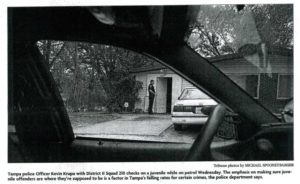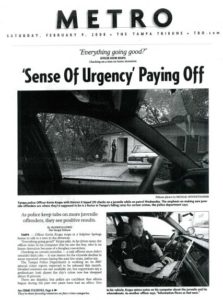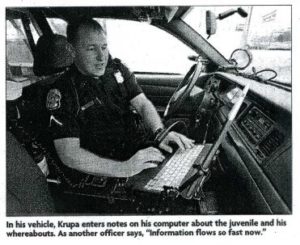As police keep tabs on more juvenile offenders, they see positive results.
 By Valerie Kalfrin
By Valerie Kalfrin
The Tampa Tribune, Feb. 9, 2008
2008 Florida Press Club Award Winner: Excellence in Crime Reporting
TAMPA — Officer Kevin Krupa stops at a Sulphur Springs house to talk to a teen in the driveway.
“Everything going good?” Krupa asks. As he drives away, the officer notes in his computer that he saw the boy, who is on home detention because of a burglary conviction.
Checking on certain juveniles — a task officers once didn’t consider their jobs — is one reason for the citywide decline in some reported crimes during the past few years, police say.
The Tampa Police Department is working on its 2007 annual crime report, expected to be released this month. Detailed statistics are not available yet, but supervisors say a preliminary look shows the city’s crime rate has dropped about 10 percent.
There are skeptics, but police are confident that efforts begun during the past two years have had effect. One initiative is a focus on property crimes, which are easier to attack and can influence violent crimes.
Each of the three police districts focuses its resources on four categories: robbery, burglary, burglary from a vehicle and vehicle theft. They also keep tabs on juveniles who are under court restrictions because of being charged with these crimes, a duty that typically fell to the Department of Juvenile Justice.
Other initiatives are tougher to measure but influential, the department said. During the past few years, officers have developed a greater sense of ownership on their beats by improving communication with the community and within the department. They also are responsible for more follow-up before filing reports.
“There’s a bigger sense of urgency,” said Maj. Gerald Honeywell, who oversees District 1, which encompasses South and West Tampa. “We do things that as a police department it’s not our job to do. We check on guys on probation, see if they’re home.”

As published in The Tampa Tribune
Christie Hess, 46, who lives in Seminole Heights, said she is pleased so far with the results in her neighborhood, where she has lived since 1994. “We engaged the police department to help us make this a better neighborhood,” she said. “Do we have prostitution problems? Sure. Because of the notoriety of Nebraska Avenue, they never really go away. But we know that if you don’t want them to take a strong foothold, you go after it right then and there. When they go away, so do the drug dealers.”
Some Crimes Can Be Prevented
Like police agencies across the country, the Tampa Police Department keeps two sets of crime statistics. One set follows Florida statutes and another follows the Uniform Crime Reporting system, a national standard.
The UCR system calculates the crime rate by tracking seven categories: homicide, aggravated assault, rape, robbery, burglary, larceny and vehicle theft.
In 2006, there were 22,717 of these offenses reported in Tampa, a decline of 9.4 percent from the previous year, according to police.
Robberies, burglaries of any kind and vehicle thefts made up about 39 percent of all crimes reported in 2006, department statistics show.
Unlike violent crimes such as homicide, which are unpredictable, “these are the crimes we know that we can impact,” said Maj. Bob Guidara, who supervises District 3, covering part of East Tampa, Ybor City and downtown.
Each district receives information daily from crime analysts plotting these crimes on a map and identifying patterns such as neighborhoods, time of day and other factors. That focus extends to monitoring juveniles on home detention or curfew for these four offenses.
One juvenile can be a walking crime wave, police say. Last year, 43 percent of the 2,396 arrests citywide for robbery, burglary, auto theft and burglary from a vehicle were juveniles, department statistics show. Of those, 36 percent were repeat offenders.
District 3 alone does about 200 checks per month on about 50 youths.
In District 2, in northeast and New Tampa, officers have noticed the checks have led to a better knowledge of their patrol zones and fewer reported instances of these four crimes, Maj. Sophia Teague said.
“When we first started checking juveniles, a lot of officers were resistant to that. They didn’t think it was their job,” she said. “But it works.”
‘Information Flows So Fast Now’
 Guidara said the police department met with the parole commission in January to discuss applying these checks to habitual adult offenders convicted of these offenses.
Guidara said the police department met with the parole commission in January to discuss applying these checks to habitual adult offenders convicted of these offenses.
Department veterans say the officers and specialty squads communicate better now, whether through e-mail, departmental computer or cell phone, and have a sense of ownership about fighting crime. If a call goes over the radio on something in progress, any available officer, whether in a specialty squad or in patrol, will respond. “It’s not somebody else’s issue,” Guidara said.
This collaboration extends to the major crimes bureau, where Maj. George McNamara also receives daily information from crime analysts on what crimes have occurred and where. Detectives confer with patrol officers about needed leads while forensic technicians from the crime scene unit now work on the street for a few hours daily so they can respond to crimes in progress.
“The information flows so fast now,” McNamara said. “You pop these bulletins out — we’re looking for this person, this vehicle — these men and women in patrol will find them for you.”
Crime reporting has become more accurate since the officers do more investigation after initial reports, these supervisors say. For instance, instead of just filing a report of a stolen cell phone, they follow up within a few days to ask whether the phone has been found. They also immediately check whether a credit card is being used when someone reports one stolen.
“We make sure it’s a crime now,” Honeywell said.
Numbers Massaged?
To skeptics such as former Tampa police Capt. Marion Lewis, this sounds like “they creatively look for ways not to write a report.”
Lewis, who lost his position during a failed mayoral bid last year and is seeking reinstatement, thinks the crime drop may be more a factor of manipulation than proactive efforts. He said that since October, neighborhood groups have heard police Chief Stephen Hogue talk about the forecasted 10 percent crime drop.
‘‘When you look at all the growth in population, how can TPD have a double-digit crime reduction?” Lewis said.
The Florida Department of Law Enforcement last year reviewed Tampa police reports from January 2007 after complaints about the department’s record keeping were made to the Legislature’s Office of Program Policy Analysis and Government Accountability. The review pronounced the department’s crime reporting accurate; however, the state noted that because the review was outside the years questioned — 2002 to 2006 — the results could not be generalized to those years.
Supervisors call the skepticism an attack on the officers’ good work.
Krupa, a 12-year veteran, said he has never had a supervisor reclassify a report to a crime it wasn’t.
“I’m not going to skew anything for the sake of a number,” he said. “I’m doing a disservice to myself. If somebody’s home is burglarized, it’s burglarized.”
There are things that aren’t captured in statistics, however. Economic crimes such as identity theft and fraud rose about 39 percent from 2006 to 2007, but this category is not tabulated in the crime rate.
FDLE, on its Web site, says crime statistics are not the sole gauge of a community’s safety. Other factors include variations in population density and composition, economic conditions, culture and transportation.
Hess, for instance, says her neighborhood’s improvement in part can be attributed to a population shift to younger homeowners focused on renovation. The neighbors communicate well, she said, but some still say they feel foolish calling the police about something that appears suspicious.
“People are afraid to call the police. ‘Well, I didn’t know if it was an emergency, so I didn’t want to bother the police.’ Bother the police? That’s what they’re there for,” Hess said.
